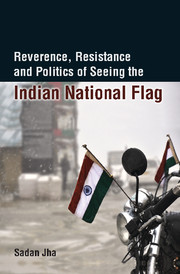Book contents
- Frontmatter
- Contents
- List of Figures
- Preface
- Acknowledgements
- Introduction
- 1 Rise of the Flag
- 2 Flag on the Hut: Totem and a Political Symbol
- 3 The Indian National Flag as a Site of Daily Plebiscite
- 4 Shades of History: A Case of Saffron Colour
- 5 Visualizing an Ideal Political Order
- 6 A Post-Colonial Symbol
- 7 Gendered Symbol, Communal Politics
- Epilogue The Flag as a Sacred Political Symbol
- Bibliography
- Index
5 - Visualizing an Ideal Political Order
Published online by Cambridge University Press: 18 December 2015
- Frontmatter
- Contents
- List of Figures
- Preface
- Acknowledgements
- Introduction
- 1 Rise of the Flag
- 2 Flag on the Hut: Totem and a Political Symbol
- 3 The Indian National Flag as a Site of Daily Plebiscite
- 4 Shades of History: A Case of Saffron Colour
- 5 Visualizing an Ideal Political Order
- 6 A Post-Colonial Symbol
- 7 Gendered Symbol, Communal Politics
- Epilogue The Flag as a Sacred Political Symbol
- Bibliography
- Index
Summary
Impression
You might ask mockingly: “A flag? What's that? A stick with a rag on it?”
No sir, a flag is much more. With a flag you lead men, for a flag, men live and die. In fact, it is the only thing for which they are ready to die in masses, if you train them for it. Believe me, the politics of entire people … can be manipulated only through the imponderables that float in thin air.
Introduction
In the previous chapter, we have seen that the colours of the flag were endowed with specific understanding of the past and history. In the decade of 1920s, with an overcast sky of communal violence, these notions of the past not merely gave popularity to the equation between colour and community but later also forced Congress leaders to rethink the design of the flag. The call of the hour was to distantiate between colours and their identification with communities. This rejection of the communal interpretation of the flag (what we see in the decision of the Congress Working Committee while giving a verdict on the new design of the official flag of the Congress in 1931) was guided both by the violent happenings of the decade of 1920s as well as by the concerns to protect the future. A flag with non-communal colours was needed to project an ideal future order. This coming together of the encoded past along with a desired future gave the tricolour its unique status and it jostled to invade every nook and corner in the coming decades of the 1930s and 1940s.
Soon after the Indian National Congress came out with an official flag in 1931, a lady running Siddhananda Medical Hall in Madras wrote a letter to Jawahar Lal Nehru. She was seeking a favour with a testimonial expressing Nehru's opinion about one of the products of Siddhananda Medical Hall. This was ‘Nehru Tooth Paste’. She sent three tubes for the personal use of Nehru and his sisters and further requested to get a certificate from Mrs Nehru and Jawaharlal Nehru's beloved sisters.
- Type
- Chapter
- Information
- Publisher: Cambridge University PressPrint publication year: 2016



